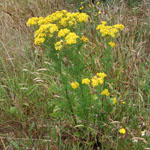Ragwort
Common name:
- Ragwort
Scientific name:
- Senecio jacobaea L.
Plant status
Catchment management authority boundaries
Regionally prohibited in the Goulburn Broken and North East catchments.
Regionally controlled in the Glenelg Hopkins, Corangamite, East Gippsland, West Gippsland, Port Phillip and Western Port catchments.
Restricted in the Mallee, Wimmera and North Central catchments.
Plant biology
Appearance
Herbaceous plant — Forb (flowering herbaceous plant — not a grass)
Description
Ragwort is a biennial or perennial herb, reproducing from crowns, roots and seeds.
Stems
Ragwort produces single or several stems that are erect and usually 45 to 60cm (up to 1.8m) high.
They are rigid, reddish or purple near base, branched at top, furrowed and sometimes bear cobweb-like hairs.
Leaves
Leaves of ragwort are dark to mid-green on upper surface, paler and sometimes downy underneath and up to 35cm long. They are deeply divided and wrinkled.
Rosette leaves are stalked, stem leaves are without stalks.
The base of leaves on upper stems have ear-like lobes around the stems. Young leaves are sometimes covered with cobweb-like hairs. Lower leaves die off as the flowering stalk emerges.
Flowers
Ragwort flowers are bright yellow with daisy-like heads in large clusters at the ends of branches.
Each head is about 2.5cm in diameter with 12 to 15 ligulate florets (bearing strap-like petals) and 30 to 50 tubular (disc) florets.
Growth and lifecycle
Method of reproduction and dispersal
Ragwort seeds are spread by wind, water, animals, farm implements, agricultural produce including hay, on clothing and other equipment.
Most seeds fall near the parent plant, but many become airborne and travel for long distances. Seeds readily float in water.
Rate of growth and spread
In its first year, a ragwort seedling grows to form a rosette. In its second year, some plants mature and flower while others may be up to five years old before flowering. Many plants die as rosettes.
Seedlings appear mostly in autumn and spring, and grow as rosettes until spring of the following year when more upright foliage (the 'cabbage' stage) is produced.
Flowering stalks develop later in spring and summer, with peak flowering from late January through to March.
Odd plants may flower at any time.
Plants turn brown and die after seed set.
Seedbank propagule persistence
Ragwort seeds can remain viable in the soil for 8 to 16 years.
Preferred habitat
Ragwort prefers humid temperate areas with an annual rainfall greater than 750mm. The weed is usually found on heavy soils of moderate fertility.
Ragwort is common in poorly managed or degraded pastures. The plant is also found in natural areas, particularly near the coast. The weed is tolerant of frost and is known to have some tolerance to drought.
Distribution
Ragwort is widespread as a pasture weed throughout high rainfall areas of southern Victoria.
Growth calendar
The icons on the following table represent the times of year for flowering, seeding, germination, the dormancy period of Ragwort and also the optimum time for treatment.
| Jan | Feb | Mar | Apr | May | Jun | Jul | Aug | Sep | Oct | Nov | Dec | |
|---|---|---|---|---|---|---|---|---|---|---|---|---|
| Flowering | ||||||||||||
| Seeding | ||||||||||||
| Germination | ||||||||||||
| Dormancy | ||||||||||||
| Treatment |
Impact
Impact on ecosystems and waterways
Ragwort can be invasive on roadsides, in forestry plantations, native forests and woodlands, threatening biodiversity in these areas.
Agricultural and economic impacts
The weed is poisonous to grazing animals, both when fresh and dried in fodder. It causes cumulative liver damage leading to photosensitisation, jaundice, wasting and sometimes death in animals.
Dairy cattle forced to graze ragwort produce tainted milk. Ragwort is a major pasture weed particularly on land grazed by cattle and horses and on dairy farms. It produces dense foliage close to the ground which suppresses and prevents regeneration of other vegetation.Ragwort competes strongly with more desirable plants, reducing pasture productivity and the value of agricultural land.
Management
Prescribed measures for the control of noxious weeds:
- application of a registered herbicide
- cultivation
- physical removal
Read about prescribed measures for the control of noxious weeds.
Other management techniques
Changes in land use practices and spread prevention may also support ragwort management after implementing the prescribed measures.